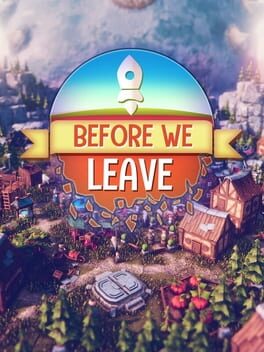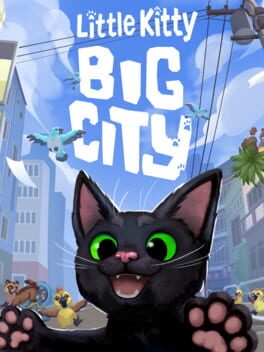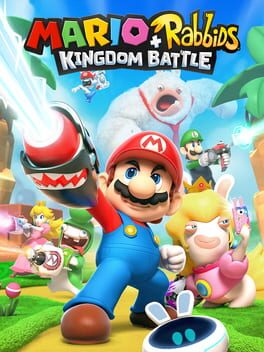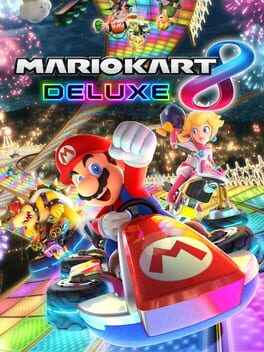talesbrenoan
35 Reviews liked by talesbrenoan
The Survivalists
2020
The Survivalists
2020
Nexomon: Extinction
2020
The absolute best Pokemon clone and stands alongside the best actual Pokemon games (Gen V).
Engaging anime style storyline. Interesting monster designs. Lots of type matchups. Battling is deeper than most Pokemon games but not as engaging as TemTem. Still the story and art style make it worth the $20 to play it.
Engaging anime style storyline. Interesting monster designs. Lots of type matchups. Battling is deeper than most Pokemon games but not as engaging as TemTem. Still the story and art style make it worth the $20 to play it.
Before We Leave
2020
There's definitely a solid core of crunchy city-building within this game. The core logic of a hex-based map with various adjacency bonuses is smart, giving rise to a lot of emergent strategy out of a relatively understandable set of mechanics. But it fumbles many of the details that are necessary to grow that idea into a complete game, and ends up a frustrating shadow of what it could have been.
While my wife and I played this game together, we came up with a laundry list of complaints about it ranging from the control scheme (Why is there no hotkey for switching between planets?) to the UI decisions (Adjusting storage in a warehouse is a nightmare) to the onboarding (Why is there no Civilopedia equivalent? Why doesn't it explain core concepts like "an action"?). But ultimately, our biggest issues fell into two categories: transparency and suburbism.
The first is especially egregious in comparison to The Colonists, which is an excellent city-builder largely because it gives the player so much visibility into and control over the details of how resources flow through your civ. This is crucial for games like this, because it provides another avenue of emergent strategy, but it's totally absent in Before We Leave where you can see resources in motion, but you can't easily track them at rest or understand how their flow operates over time. It's hard to understand the paths your peeps travel even though the adjacency mechanics make this pathing critical to the player's success.
Specifically, passing near certain tiles (fountains, trees) improves the mood of a given peep while passing near others (tall buildings, pollution) makes them unhappy. Because housing imposes substantial tall building "gloom" penalties and the best food production produces pollution, you're incentivized to reproduce a suburban city layout with home, work, and food separated strictly by function. While this could pose an interesting mechanical puzzle, as a human player I want to build a city I'd like to live in. I personally love walking among mixed-use apartments, row houses, and restaurants and it's a bummer to play a game that frames that as bad.
Even the mechanical puzzle kind of sucks, though. The gloom mechanic discourages density of housing, but housing adjacency bonuses are so strong as to outweigh that completely—meaning that you just have an ambient gloom penalty all the time that you can't really address. As the game moves to later stages, this seems to be its constant theme: it keeps asking you to cram more and more things into the same number of tiles without giving you tools to improve efficiency or positive motivation to rethink layouts. (There is one notable counterexample, the step warehouse, which is worth highlighting because I wish the game had more improvements like that.)
This was a fun few hours of initial exploration, but the substantial amount of lategame content (including fighting off hostile NPCs which we haven't even talked about) just felt like a slog. And just to add insult to injury, the unlockable "reward" tiles like the Park and the Pond simply do nothing at all! What is the point.
While my wife and I played this game together, we came up with a laundry list of complaints about it ranging from the control scheme (Why is there no hotkey for switching between planets?) to the UI decisions (Adjusting storage in a warehouse is a nightmare) to the onboarding (Why is there no Civilopedia equivalent? Why doesn't it explain core concepts like "an action"?). But ultimately, our biggest issues fell into two categories: transparency and suburbism.
The first is especially egregious in comparison to The Colonists, which is an excellent city-builder largely because it gives the player so much visibility into and control over the details of how resources flow through your civ. This is crucial for games like this, because it provides another avenue of emergent strategy, but it's totally absent in Before We Leave where you can see resources in motion, but you can't easily track them at rest or understand how their flow operates over time. It's hard to understand the paths your peeps travel even though the adjacency mechanics make this pathing critical to the player's success.
Specifically, passing near certain tiles (fountains, trees) improves the mood of a given peep while passing near others (tall buildings, pollution) makes them unhappy. Because housing imposes substantial tall building "gloom" penalties and the best food production produces pollution, you're incentivized to reproduce a suburban city layout with home, work, and food separated strictly by function. While this could pose an interesting mechanical puzzle, as a human player I want to build a city I'd like to live in. I personally love walking among mixed-use apartments, row houses, and restaurants and it's a bummer to play a game that frames that as bad.
Even the mechanical puzzle kind of sucks, though. The gloom mechanic discourages density of housing, but housing adjacency bonuses are so strong as to outweigh that completely—meaning that you just have an ambient gloom penalty all the time that you can't really address. As the game moves to later stages, this seems to be its constant theme: it keeps asking you to cram more and more things into the same number of tiles without giving you tools to improve efficiency or positive motivation to rethink layouts. (There is one notable counterexample, the step warehouse, which is worth highlighting because I wish the game had more improvements like that.)
This was a fun few hours of initial exploration, but the substantial amount of lategame content (including fighting off hostile NPCs which we haven't even talked about) just felt like a slog. And just to add insult to injury, the unlockable "reward" tiles like the Park and the Pond simply do nothing at all! What is the point.
Inside
2016
Animal Well
2024
Ok I think I’ve done all that I want to now. Got all the bunnies and got help solving the wing dings code to get to the last big secret in the game. Ngl got a little bit emotional again when I finally solved the final big puzzle. This game is so great. I love it so much. There’s still some figurines I haven’t gotten and I may come back and learn how to speedrun this game but for now I think I’ve had my fun. This is the kind of game I’ve been waiting a long time to experience. Thank you Billy Basso you made something extraordinary.
Jogado no Xbox Game Pass. A proposta e a fofura funcionam extremamente bem, mas eu acho que o resultado final de gameplay acabou ficando raso demais. O movimento (e principalmente o pulo) são meio estranhos, as missões são repetitivas demais e você tem vários elementos subaproveitados (como o miado ou os emotes). Eu ainda quero voltar e fazer 100%, mas não senti vontade de fazer isso já.
Theme Hospital
1997
Mario Kart 8 Deluxe
2017
Botany Manor
2024
Botany Manor é um bom jogo de puzzle, que eu considero ser relativamente fácil. Diria, portanto, que é um bom jogo para iniciantes e intermediários nesse gênero.
Por incrível que pareça, o jogo ainda possui uma trama que contextualiza a importância da protagonista estar estudando as plantas e os puzzles se encaixam perfeitamente nisso.
Vale muito a pena!
Por incrível que pareça, o jogo ainda possui uma trama que contextualiza a importância da protagonista estar estudando as plantas e os puzzles se encaixam perfeitamente nisso.
Vale muito a pena!
Initially felt inclined to rate The Lost Crown slightly lower due to some minor annoyances brought about by glitches, but by the end, I realised it represents too much of what I want out of this industry to lowball it. This game’s not just a welcome franchise revival or a showcase of a big publisher’s willingness to get experimental, it’s equally a reminder that not enough people are aware of what consistently great developers Ubisoft Montpellier are, an exercise in hardcore Indo-Persian frisbeeing, a vindication of Warrior Within enjoyers and – if you ask me – the single best search-‘em-up outside of actual Metroid games.
There’s a few indicators that Warrior Within was a point of study here – Sargon dual wields swords, it’s bloodier and more combat-oriented than most other entries, creatures from Persian folklore play a bigger role compared to original monsters and the Prince’s outfit from it was a preorder bonus – but the main one is that Warrior Within was Prince of Persia’s precedent for experimenting with a Metroid-y overworld. That more exploratory angle was always why I liked it best, so it’s just as well that The Last Crown expands on this like a duck to water. Mount Qaf’s dishing out surprises so regularly that the game never once feels stale despite how much longer it is than most of this genre, which is thanks not just to the conceptual creativity and sheer number of its biomes but also how those concepts inform their mechanics. To mention just one, my favourite’s the labyrinthine library whose master’s hunger for knowledge ended up turning him into Mr. X, in which you have to juggle that looming threat with puzzles where realising the solution is only part of the equation; showing you how I did this particular one isn’t even really a spoiler, because the onus is still as much on your dexterity and forward-planning as on figuring out what to do. Comparatively straightforward, linear areas aren’t without some kind of distinctive pull or spectacle either, one major highlight being pressing the resume button on a naval battle which had been frozen in time centuries ago.
That sort of moment-to-moment variety goes a big way towards helping avoid the staleness or tedium that could’ve been invited by its length, but the biggest asset in that regard is what a joy it is to gradually unravel Mount Qaf. I love the powers in this to the point that I’m hoping future metroidbraniacs rip them off wholesale. Nearly every individual one of them opens up several means of approach in both platforming and combat by itself; teleporting to an afterimage with Shadow of the Simurgh to slip through obstacles or set up multiple charged attacks quicker than you normally could, phasing between realities like in Soul Reaver to control when certain enemies or platforms become tangible, stuffing an explosive in your pocket to unveil a hidden respite in a precision platforming segment or even an entire enemy to even the odds in a particularly tough encounter… Every time I unlocked a new one, my mind was racing at the possibilities. Combine just a few with a little out-of-the-box thinking and it feels like you can reach just about anywhere – I’ve no idea how you’re “supposed” to get past the bit in that clip normally, and that’s beautiful.
Its combat designers similarly outdo themselves. Experimentation’s the name of the game, in part thanks to the impressive amount of hit reactions on its enemies’ part. They and bosses can be varyingly be tripped, launched, juggled, wallsplatted and more, but these differ heavily according to their weight class, which contributes to them being as varied functionally as visually in addition to making target prioritisation pretty frantic whenever big bois are mixed in with little ones. Coupled with the aforementioned powers, your means of approach are spruced up by the extent to which you can alter Sargon’s attributes through an equivalent to Hollow Knight’s charm system. I personally set him up with a ranged shockwave on melee attacks and another letting you turn the chakram into a lingering hazard, with an additional one that heals you on successful parries in case I ran out of potions during the increasingly tough later levels and their gleefully Shonen boss fights, but the customisation on offer’s such that your combat comfort zone’ll likely be pretty different. The feedback on attacks also deserves credit, seemingly taking pointers from Dreadtroid in that respect (love the slight screenshake on each hit in particular). As I said to a friend of mine, himself a French weeb, I’d loosely compare The Lost Crown to Streets of Rage 4 in that it represents what happens when a bunch of French weebs get together and stuff as much of whatever they think is coolest into a game as possible: an exhibition of action gameplay so well-studied and thoroughly understood you’d swear it was made by the Japanese genre figureheads they so clearly admire.
Same goes for its visual artists and the carvers of ancient rock reliefs they palpably draw inspiration from. It’s a delight to see this series dig deeper into the historical iconography of its namesake, ornate Faravahars and esoteric cuneiform and all, tempered by the hand of Rayman Legends’ art director to drape it all in this lovely cartoony, stylised edge. I imagine part of why it runs so well both handheld and docked’s due in part to some clever tricks the artists use with the backgrounds and certain characters too, rendering them with painted 2D images as opposed to fully textured 3D models; really lends figures like the Simurgh and places like the Crossroads of Time an otherworldly feel.
I’ve always been iffy on how “Ubisoft” is used as a descriptor, partially because it often crops up regardless of how similar the game it’s used in reference to actually is to any of their games, but also because there are so many Ubisofts that you can’t really talk about them like they’re a singular entity. I mentioned in my Chaos Theory review that I find it hard not to retain some goodwill towards them so long as at least some of their oldheads remain, and while that holds true, The Lost Crown’s also a compelling case for their newcomers. It’s clear evidence that there’s a swathe of latent talent amongst the group’s bloated headcount primed and ready for the chance to be let off the mobile game hamster wheel and deliver some genre-best efforts, with such avalanches of great ideas that I haven’t even mentioned Memory Shards or that this has a Persian Vergil who uses the 3D games’ time powers against you. Severely hoping Ahriman decides to lay off for a bit so that this game and the people behind it can see the success they deserve, and so we can get more of those in turn.
There’s a few indicators that Warrior Within was a point of study here – Sargon dual wields swords, it’s bloodier and more combat-oriented than most other entries, creatures from Persian folklore play a bigger role compared to original monsters and the Prince’s outfit from it was a preorder bonus – but the main one is that Warrior Within was Prince of Persia’s precedent for experimenting with a Metroid-y overworld. That more exploratory angle was always why I liked it best, so it’s just as well that The Last Crown expands on this like a duck to water. Mount Qaf’s dishing out surprises so regularly that the game never once feels stale despite how much longer it is than most of this genre, which is thanks not just to the conceptual creativity and sheer number of its biomes but also how those concepts inform their mechanics. To mention just one, my favourite’s the labyrinthine library whose master’s hunger for knowledge ended up turning him into Mr. X, in which you have to juggle that looming threat with puzzles where realising the solution is only part of the equation; showing you how I did this particular one isn’t even really a spoiler, because the onus is still as much on your dexterity and forward-planning as on figuring out what to do. Comparatively straightforward, linear areas aren’t without some kind of distinctive pull or spectacle either, one major highlight being pressing the resume button on a naval battle which had been frozen in time centuries ago.
That sort of moment-to-moment variety goes a big way towards helping avoid the staleness or tedium that could’ve been invited by its length, but the biggest asset in that regard is what a joy it is to gradually unravel Mount Qaf. I love the powers in this to the point that I’m hoping future metroidbraniacs rip them off wholesale. Nearly every individual one of them opens up several means of approach in both platforming and combat by itself; teleporting to an afterimage with Shadow of the Simurgh to slip through obstacles or set up multiple charged attacks quicker than you normally could, phasing between realities like in Soul Reaver to control when certain enemies or platforms become tangible, stuffing an explosive in your pocket to unveil a hidden respite in a precision platforming segment or even an entire enemy to even the odds in a particularly tough encounter… Every time I unlocked a new one, my mind was racing at the possibilities. Combine just a few with a little out-of-the-box thinking and it feels like you can reach just about anywhere – I’ve no idea how you’re “supposed” to get past the bit in that clip normally, and that’s beautiful.
Its combat designers similarly outdo themselves. Experimentation’s the name of the game, in part thanks to the impressive amount of hit reactions on its enemies’ part. They and bosses can be varyingly be tripped, launched, juggled, wallsplatted and more, but these differ heavily according to their weight class, which contributes to them being as varied functionally as visually in addition to making target prioritisation pretty frantic whenever big bois are mixed in with little ones. Coupled with the aforementioned powers, your means of approach are spruced up by the extent to which you can alter Sargon’s attributes through an equivalent to Hollow Knight’s charm system. I personally set him up with a ranged shockwave on melee attacks and another letting you turn the chakram into a lingering hazard, with an additional one that heals you on successful parries in case I ran out of potions during the increasingly tough later levels and their gleefully Shonen boss fights, but the customisation on offer’s such that your combat comfort zone’ll likely be pretty different. The feedback on attacks also deserves credit, seemingly taking pointers from Dreadtroid in that respect (love the slight screenshake on each hit in particular). As I said to a friend of mine, himself a French weeb, I’d loosely compare The Lost Crown to Streets of Rage 4 in that it represents what happens when a bunch of French weebs get together and stuff as much of whatever they think is coolest into a game as possible: an exhibition of action gameplay so well-studied and thoroughly understood you’d swear it was made by the Japanese genre figureheads they so clearly admire.
Same goes for its visual artists and the carvers of ancient rock reliefs they palpably draw inspiration from. It’s a delight to see this series dig deeper into the historical iconography of its namesake, ornate Faravahars and esoteric cuneiform and all, tempered by the hand of Rayman Legends’ art director to drape it all in this lovely cartoony, stylised edge. I imagine part of why it runs so well both handheld and docked’s due in part to some clever tricks the artists use with the backgrounds and certain characters too, rendering them with painted 2D images as opposed to fully textured 3D models; really lends figures like the Simurgh and places like the Crossroads of Time an otherworldly feel.
I’ve always been iffy on how “Ubisoft” is used as a descriptor, partially because it often crops up regardless of how similar the game it’s used in reference to actually is to any of their games, but also because there are so many Ubisofts that you can’t really talk about them like they’re a singular entity. I mentioned in my Chaos Theory review that I find it hard not to retain some goodwill towards them so long as at least some of their oldheads remain, and while that holds true, The Lost Crown’s also a compelling case for their newcomers. It’s clear evidence that there’s a swathe of latent talent amongst the group’s bloated headcount primed and ready for the chance to be let off the mobile game hamster wheel and deliver some genre-best efforts, with such avalanches of great ideas that I haven’t even mentioned Memory Shards or that this has a Persian Vergil who uses the 3D games’ time powers against you. Severely hoping Ahriman decides to lay off for a bit so that this game and the people behind it can see the success they deserve, and so we can get more of those in turn.
Pentiment
2022
In terms of "heavy on reading" narrative game, this is not as dynamic and interactive as a Telltale game like The Wolf Among Us nor as richly built and in-depth as Disco Elysium. It is its own thing, but not always for the better.
My main issue is that the game is to grounded in reality, trying to portrait what's authentic and how life was like in this period. This results in a myriad of conversations and small talks about villages, farming, food, religion, faith, family, etc. If this sounds like your thing, than you're in for a treat. I, on the other hand, would've liked a more fantastical approach to the narrative. The dream sequences and the inner monologues are a great starting point, but it needed to expend in that direction.
The pacing is also quite tedious. I ended up getting used to the flow of the game near the middle of the second act, but without spoiling anything, it changed back up in the last act and made thing so slow once again.
If you're a medieval history nerd or are interested in diving deeper into a religious setting, than you'll probably enjoy this a lot. I certainly respect this game for what it was trying to achieve, but I don't think it'll succeed for everyone.
My main issue is that the game is to grounded in reality, trying to portrait what's authentic and how life was like in this period. This results in a myriad of conversations and small talks about villages, farming, food, religion, faith, family, etc. If this sounds like your thing, than you're in for a treat. I, on the other hand, would've liked a more fantastical approach to the narrative. The dream sequences and the inner monologues are a great starting point, but it needed to expend in that direction.
The pacing is also quite tedious. I ended up getting used to the flow of the game near the middle of the second act, but without spoiling anything, it changed back up in the last act and made thing so slow once again.
If you're a medieval history nerd or are interested in diving deeper into a religious setting, than you'll probably enjoy this a lot. I certainly respect this game for what it was trying to achieve, but I don't think it'll succeed for everyone.












